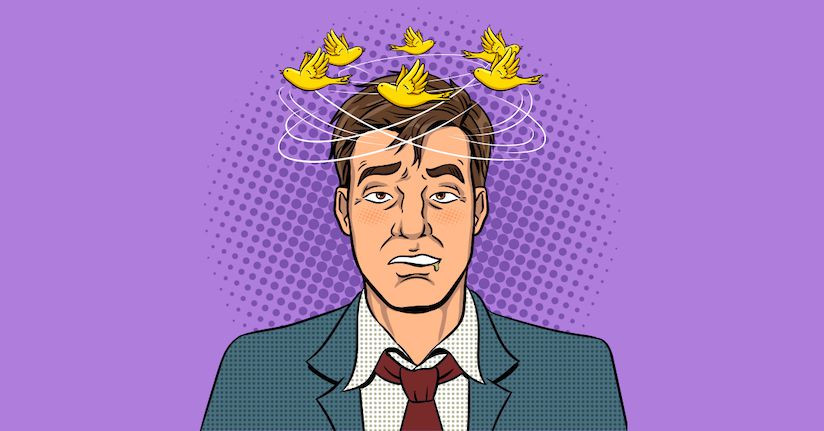Dizziness
DIZZINESS WITH DR. HUTFLES
Image from: https://www.theraspecs.com/blog/dizziness-vertigo-post-concussion-syndrome/
TODAY'S PEARLS
1. Central vs. peripheral causes of vertigo.
2. HINTS exam: to differentiate central vs. peripheral causes of vertigo
3. Cerebellar Stroke: When to worry.
Dr. Hutfles presented a patient who presented with dizziness and was found to have a large cerebellar ischemic stroke. The patient's course was complicated by cerebral edema leading to effacement of the 4th ventricle, with subsequent brainstem compression & herniation.
Vertigo

Other causes of vertigo:
Meniere disease: accompanied by ear fullness or pain, hearing loss.
Vestibular migraine: hx of migraine, accompanied by headache.
Ramsay Hunt syndrome: herpes zoster
Aminoglycoside toxicity
Acoustic neuroma: hearing loss
THE HINTS EXAM:
Kattah, J. et al. "HINTS to Diagnose Stroke in the Acute Vestibular Syndrome: Three-Step Bedside Oculomotor Examination More Sensitive Than Early MRI Diffusion-Weighted Imaging". Stroke. 2009. 40(11):3504–3510.HINTS is a 3-part oculomotor physical exam designed to help differentiate between a peripheral and central etiology of vertigo.
ONLY for use in patients with ongoing/continuous vertigo.
THE THREE COMPONENTS

Rainer, Spiegel et. al. Dizziness in the emergency department: an update on diagnosis. Swiss Med Wkly. 2017;147:w14565. https://doi.org/10.4414/smw.2017.14565.
h-HIT (Horizontal head impulse test):
- How to:
- Ask patient to focus on your nose.
- Rotate the patient's head 20-40 degrees to the right or left
- Observe for nystagmus. Watch for one eye to lag and then catch up with a quick saccade.
- Lots of examples starting at 15 minutes in this video: https://www.youtube.com/watch?v=XpghlvnrREI
- Normal result in peripheral vertigo: One eye will lag and then catch up with a quick saccade.
- HINTS positive: If there is no lag/saccade & the patient's eyes stay fixed on your nose. That's right, if the test is normal/negative, you should be worried about stroke.
Nystagmus:
- How to:
- Observe the patient & have them move their eyes laterally.
- Normal Result: If nystagmus is present it should be unidirectional.
- HINTS positive: If any other type of nystagmus is seen (vertical, bidirectional).
- Video example at 2:30 --> https://www.youtube.com/watch?v=1q-VTKPweuk
Skew:
- How to:
- Alternately cover one eye and then the other without touching the patient. Watch for vertical or diagonal movement of the uncovered eye.
- Normal Result: No eye movement.
- HINTS positive: Vertical or diagonal movement of the uncovered eye.
- Video example at 3:35 --> https://www.youtube.com/watch?v=1q-VTKPweuk
HINTS exam Positive (i.e. central) if:
✓Patient with at least 1 stroke risk factor✓Any one of the 3 tests (HIT, nystagmus or skew) are positive
✓No history of recurrent vertigo
HINTS Exam operating characteristics according to the Kattah et al study: “100% sensitive and 96% specific for stroke”
 D.E. Haines, G.A. Mihailoff, in Fundamental Neuroscience for Basic and Clinical Applications (Fifth Edition), 2018
D.E. Haines, G.A. Mihailoff, in Fundamental Neuroscience for Basic and Clinical Applications (Fifth Edition), 2018
In addition to standard stroke management....
There are things to remember when medically managing a posterior circulation stroke:
- Cerebral edema usually causes decreased LOC & can occur 1-7 days after stroke with a mean incidence at 3 days. Patients with posterior circulation strokes need to be monitored closely because of this.
- Mannitol or hypertonic saline can help in mild cases of cerebral edema.
- If edema occurs & begins to cause obstruction/compression, emergent craniotomy or EVD placement are required.
Wright, James et. al. Diagnosis and Management of Acute Cerebellar Infarction. Stroke 2014;45:e56–e58.
Posterior Circulation Stroke
Illness script:
Patient with persistent vertigo & positive HINTS exam, OR focal neurologic deficits.
Diagnosis:
- CT head non-contrast: has poor utility & can easily miss a posterior circulation stroke.
- MRI brain diffusion weighted imaging: much more useful.
1. Cerebellar hemorrhagic stroke
→ If e/o expanding hematoma, this is a SURGICAL EMERGENCY
2. Cerebellar ischemic stroke
→ medical management with close observation
***Risk of edema in the posterior fossa leading to obstruction of the 4th ventricle which can compress the brainstem & cause herniation ***
Cerebellar stroke most commonly occurs in the PICA distribution.

In addition to standard stroke management....
There are things to remember when medically managing a posterior circulation stroke:
- Cerebral edema usually causes decreased LOC & can occur 1-7 days after stroke with a mean incidence at 3 days. Patients with posterior circulation strokes need to be monitored closely because of this.
- Mannitol or hypertonic saline can help in mild cases of cerebral edema.
- If edema occurs & begins to cause obstruction/compression, emergent craniotomy or EVD placement are required.
Wright, James et. al. Diagnosis and Management of Acute Cerebellar Infarction. Stroke 2014;45:e56–e58.
The information posted above is for educational use only by the trainees of a non-profit hospital residency program.
Compiled by Emma


Great teaching points regarding posterior circulation strokes that can be a diagnostic challenge and carry a poor prognosis. Thanks for sharing
ReplyDelete